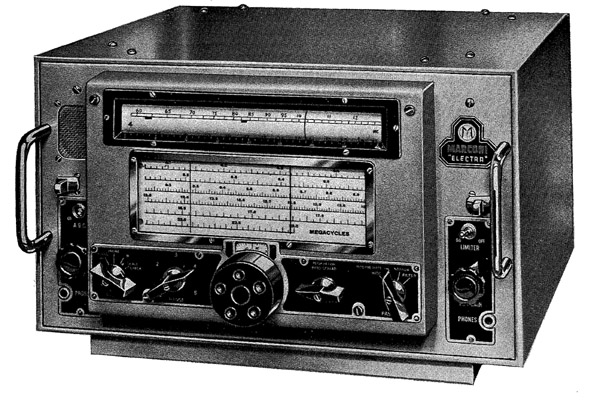 |
| Mercury (Type 1017) receiver. |
 |
| Electra (Type 1018) receiver. |
| Photos courtesy Marconi Marine International |
Type: Mercury - 12 tube, general purpose marine receiver. Also designated NS601
Electra - 13 tube, general purpose marine receiver. Also designated as NS301.
Frequency Range: 15 KHz to 25 MHz between the two receivers.
Mercury covers 15 KHz to 40 KHz and 100 KHz to 4 MHz. .
Electra covers spectrum segments from 250 KHz to 520 KHz amd 1.5 MHz to 25 MHz .
Power Input: 110 or 220 VDC ; or 230 VAC 50 Hz ; or 24 VDC using 889A or 966A power units.
Modes: AM/CW/MCW
Selectivity - Variable from 8 KHz to 150 Hz in four steps.
Manufactured between: 1953 and 1965
Weight: Receiver - 55 pounds
Power Unit - 21 pounds
Receiver dimensions in inches: 17 1/8W x 18 1/4D x 11 1/8H
Comment:These two receivers also bear the following designartors -
Mercury RS601
ElectraRS 301
The receivers were designed to be stacked one atop of another. In this instance, it is suggested by the manufacturer that the Mercury go on top and the Electra on the bottom. In practice it was most common to find the receivers in a side by side configuration.
Additional details on the Mercury and Electra receivers can be found here.
 |
| Mercury (Type 1017) receiver. |
 |
| Electra (Type 1018) receiver. |
| Photos courtesy Marconi Marine International |
 |
| In this stacked configuration the Mercury receiver is atop the Electra. The artifacts are held by the Marine Museum of British Columbia in Victoria, BC. (Photo by Frank Statham) |
Spud Roscoe adds "Often the Mercury receiver was fitted alone especially on the British Coastal ships.
When the Commonwealth World Wide Radio System was in service, a lot of British ships could use nothing but MF, from 410 to 512 KHz. Frequently, these ships would cross the "pond" with only a Mercury receiver fitted because it had 500 KHz capability. We would often hear a British ship calling the collective call of some Radio Accounting Authority on 500 KHz. They wanted a relay by a ship with the same authority they were sailing with because they had *no* HF capability".
| An Operating and Service Manual for the Mercury and Electra receivers can be found here. |
Contributors and Credits:1) Marconi Marine International - Manual
2) Frank Statham <fstatham(at)telus.net>
3) Spud Roscoe <spudroscoe(a)eastlink.ca>
4) http://www.rnmuseumradarandcommunications2006.org.uk/MERCHANT%20SHIPS%20AND%20RFA%20FITS.pdf
5) Shortwave Receivers Past & Present Communications Receivers 1942-1997 by Fred Osterman.
6) Sandy Blaize ebjr37(at)charter.net
7) David Samways <gdas1(at)bigpond.com>
8) Moe Fretz [tubetester(at)gmail.com]
Sept 26/22